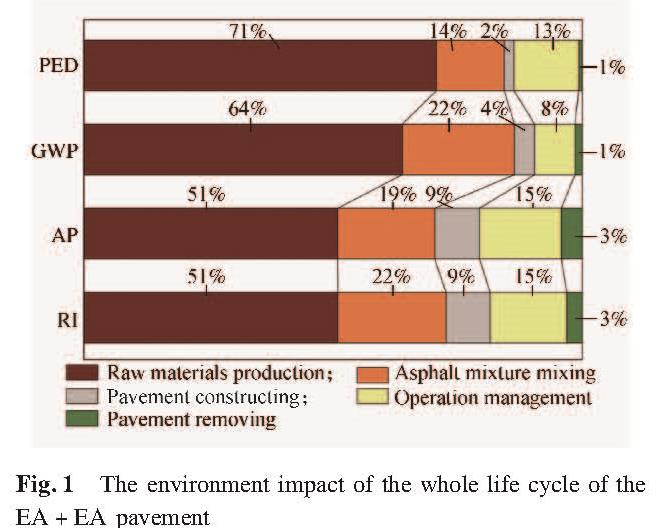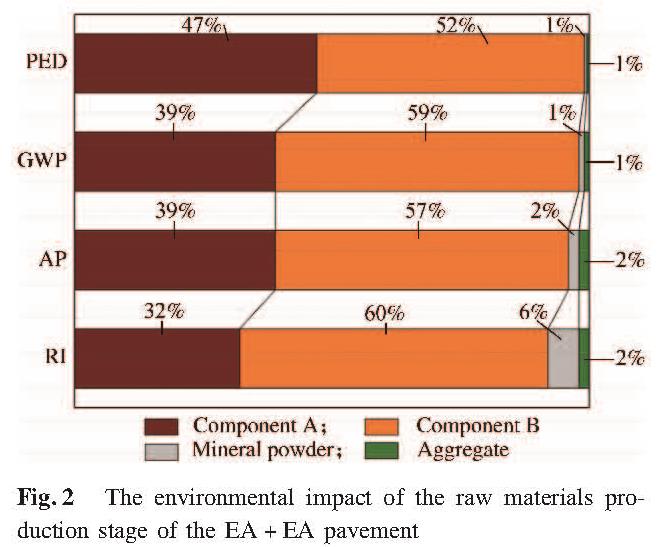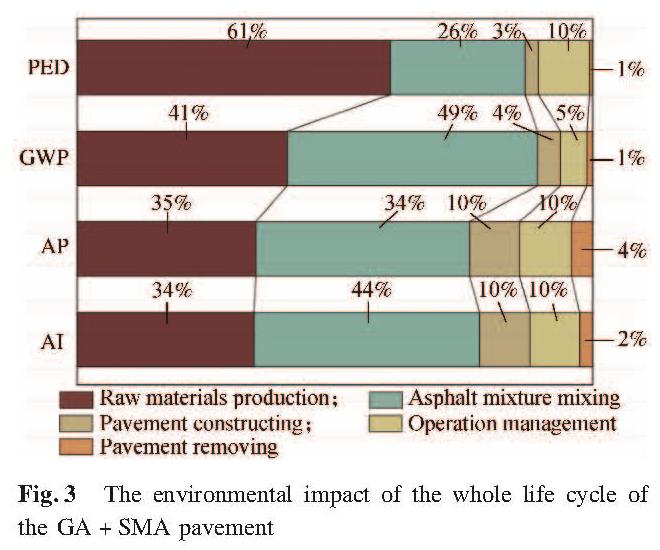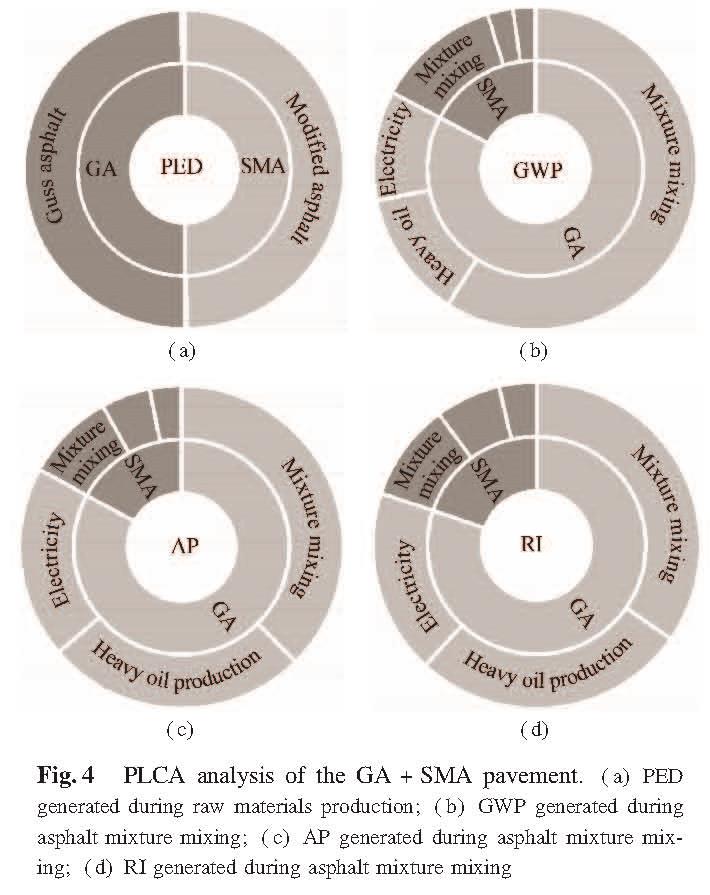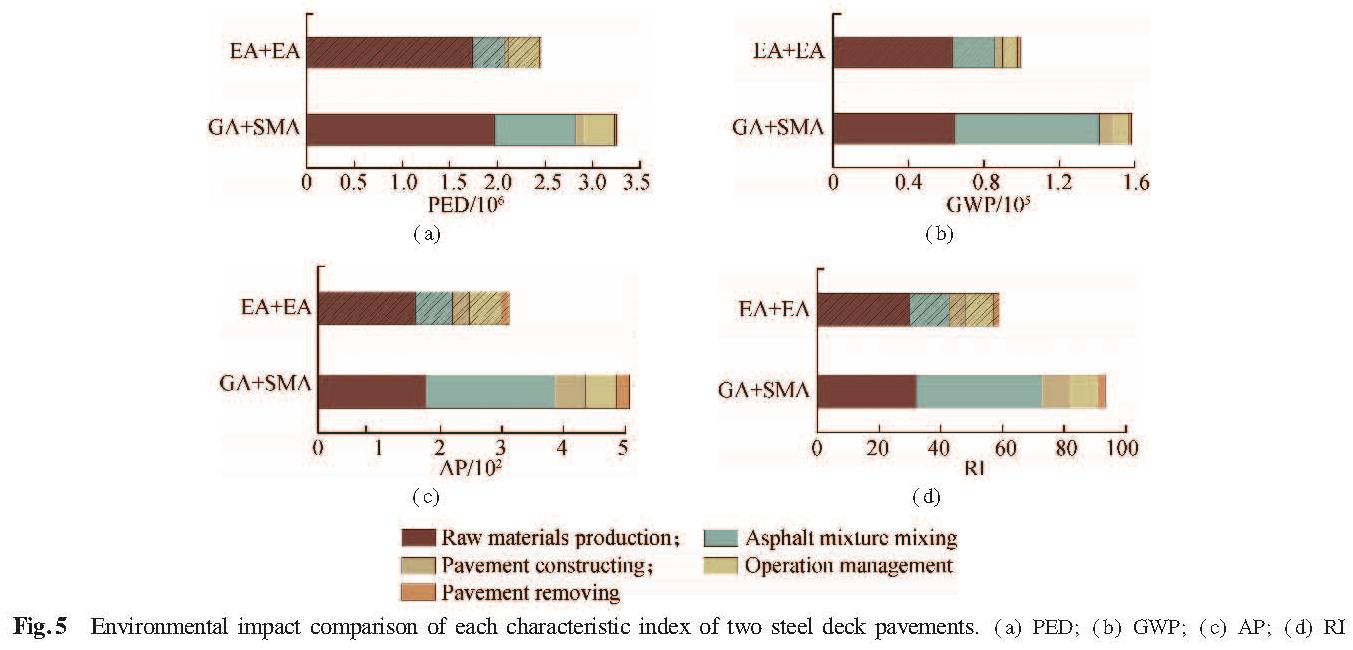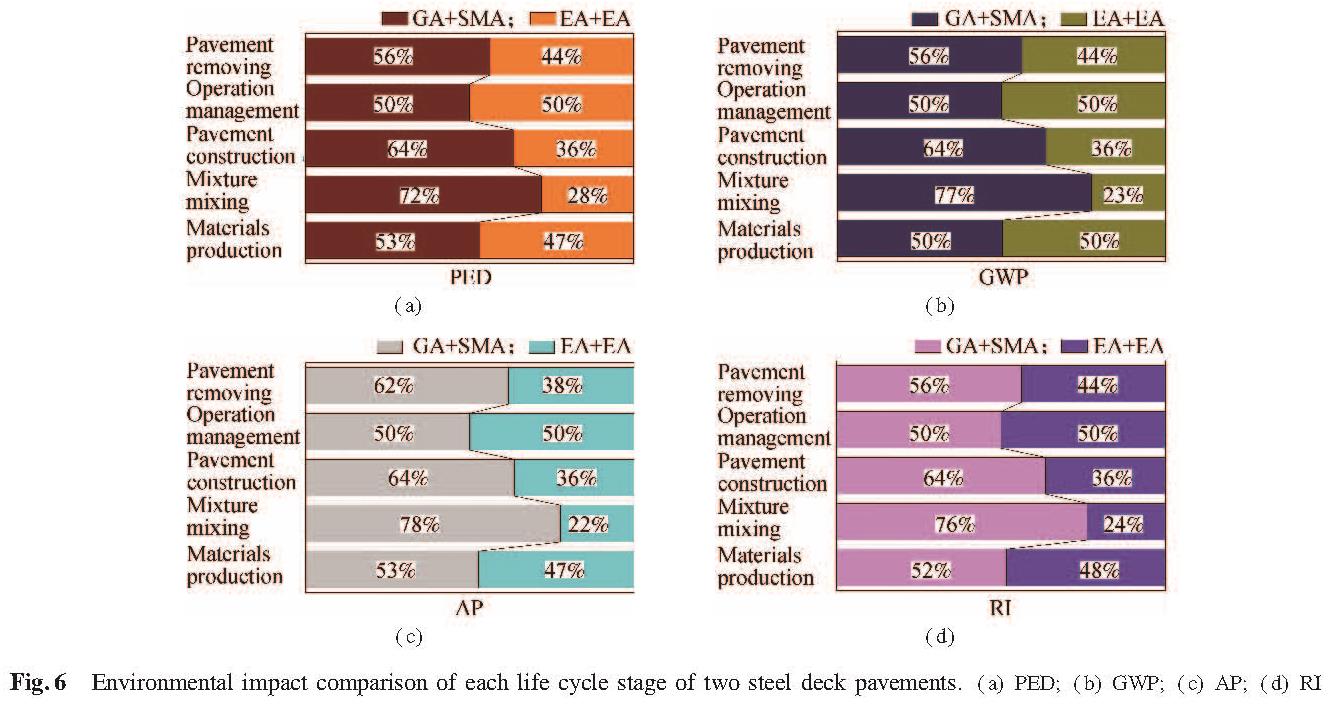为研究钢桥面铺装层在全生命周期内对环境的影响,将钢桥面铺装层的生命周期划分为原材料生产、混合料拌和、铺装层铺筑、运营管理和铺装层铲除5个阶段,并基于过程生命周期分析法,确定了钢桥面铺装层中应用较广的双层环氧和下层浇注+上层SMA两种铺装层生命周期内能耗与排放的计算方法.分析了2种铺装层的生命周期清单,构建了相应计算模型,以初级能源消耗(PED)、全球变暖潜值(GWP)、酸化(AP)和可吸入无机物(RI)4个特征化指标量化了2种钢桥面铺装层生命周期内对环境的影响.结果表明,下层浇注+上层SMA铺装层生命周期内对环境的影响是双层环氧铺装层的1.3倍以上; 双层环氧铺装层节能减排的重点在于原材料生产阶段,下层浇注+上层SMA铺装层节能减排的重点在于混合料拌合阶段.
To investigate the environmental impacts of steel deck pavement through the whole life cycle, the steel deck pavement was divided into five stages: raw materials production, asphalt mixture mixing, pavement construction, operation management, and pavement removing stage. Based on the process-based life cycle assessment(PLCA)method, the calculation methods of energy consumption and gas emissions of two typical steel deck pavement systems(EA+EA pavement and GA+SMA pavement)were determined. The data lists of two pavements were analyzed, and the calculation model was built. Four characteristic indices including primary energy demand(PED), global warming potential(GWP), acidification potential(AP)and respiratory inorganics(RI)were used to quantify the environmental impacts of two pavements. The results show that the environmental impact of the GA+SMA pavement is more than 1.3 times that of the EA+EA pavement. Moreover, the critical stage of energy-saving and emission-reduction of EA+EA pavement and GA+SMA pavement are the raw material production stage and asphalt mixture mixing stage, respectively.
Asphalt concrete has been widely used for the steel bridge deck pavement due to the excellent performance, such as light-weight and excellent distortion coordination[1-2]. However, the large-scale application of asphalt concrete in the steel bridge deck pavement has significant impacts on the environment[3]. During the construction of the steel deck pavement, not only a lot of resources and energy are consumed, but also greenhouse gases and other harmful gases are emitted[4]. According to a survey, 200 to 300 million tons of asphalt mixtures were produced in China in 2011, and the fuel consumed in the production process was equivalent to 1.2 to 1.8 million tons of diesel oil. At the same time, 3.831 to 5.747 million tons of greenhouse gases were emitted[5]. Therefore, a life cycle assessment(LCA)method was proposed by some researchers to comprehensively analyze the energy consumption and greenhouse gas emissions throughout road construction[6]. LCA is a quantitative assessment method used to analyze all environmental impacts of products, processes, or activities in the whole life cycle. Based on the LCA, the energy consumption and greenhouse gas emissions of pavement can be calculated quantitatively. It contributes to the investigation of the energy-saving and emission-reduction technology[7].
LCA was firstly used to analyze and evaluate the environmental impact of plastic packaging materials in the 1960s. The International Organization for Standardization has standardized the concept and technical framework of LCA, and a series of standards ISO 14040 has been applied and promoted around the world[8]. With the rapid development of road construction, LCA has been gradually applied to road engineering[9]. Jahanbakhsh et al.[10] applied the process-based life cycle analysis(PLCA)method to analyze the environmental impact of SMA pavement and cement concrete pavement, respectively. Estaji et al.[11] applied the hybrid life cycle analysis(HLCA)method to research the environmental impact of eight different pavement structures. Based on the LCA analysis method, Zheng[12] developed the environmental impact framework of highway engineering. It included raw materials production, pavement construction, operation management, and pavement removing. Moreover, energy consumption and greenhouse gas emissions in the life cycle of cement concrete pavement were analyzed in his study. According to the assessment results, some improvement measures and suggestions were proposed. Based on the LCA assessment method, the environmental impacts of four recycled asphalt pavement technologies were compared by Jia[13].
The present investigation of the environmental impact was focused on the pavement structures and construction materials of road engineering, while less attention was paid to the steel deck pavement. The epoxy asphalt concrete(EA),guss asphalt concrete(GA), and SMA concrete are the common paving materials for the steel deck pavement. The purpose of this article is to investigate the environmental impact of EA+EA and GA+SMA pavement by an LCA analysis model. Finally, some improvement suggestions for energy-saving and emission-reduction are proposed.
1 Assessment Method1.1 Determination of the LCA assessment systemAccording to the differences between the assessment system boundary and methodology principle, the LCA methods can be divided into three types: process-based LCA(PLCA), input-output LCA(I-O LCA), and hybrid LCA(HLCA). PLCA is the most traditional and classic assessment method. Based on the data list of energy and gas emissions during the life cycle process, the environmental impact of pavement can be analyzed by PLCA. Due to high operability and visualization, the PLCA assessment system can accurately analyze the environmental impact of a specific product. Moreover, the scope and accuracy of the assessment model can be adjusted simply based on the investigation requirements[14-15]. Therefore, the PLCA method was applied to divide each life cycle stage of the steel deck asphalt pavement into refined unit processes in this study. The energy consumption and gas emissions of each unit process were calculated and summed. Finally, the total energy consumption and gas emissions of the whole life cycle of the steel deck pavement were obtained.
1.2 Calculation methods of energy consumption and greenhouse gas emissionsAccording to the Chinese specification GB/T 2589—2008, a calculation method of net calorific value was used to calculate the overall energy consumption. It can convert various energy and resource consumption data into ordinary energy units, such as MJ. The total energy consumption can be computed by
 (1)
(1)
where E is the total energy consumption; Fi is the i-th energy consumption in the production or service process; Ni is the net calorific value of the i-th energy.
The emission factor(f)method was applied to calculate the gas emissions in the study. f refers to the gas emissions produced by per unit mass, unit volume, or unit distance activity. Based on the total energy consumption, the total gas emissions of the whole life cycle of production can be calculated by
Q=Af(1-(r)/(100))(2)
where Q is the total gas emissions; A is the active datum; r is the emission reduction.
2 PLCA Model DevelopmentIn the study, a half steel deck with a length of 500 m and a width of 11.25 m was taken as the functional unit. Therefore, the impacts of different pavement structures and design years can be eliminated; the analysis results are comparable. Based on the Chinese specification JTG D64—2015, the analysis period is 15 years. The units of quantitative analysis of energy consumption and gas emissions were determined as MJ per functional unit and kg per functional unit, respectively. The EA+EA pavement(30 mm EA mixture+30 mm EA mixture)and GA+SMA pavement(35 mm GA mixture+35 mm SMA mixture)were selected as pavement materials and structures. The aggregate-asphalt gradations used are shown in Tab.1. An efootprint software was applied to build the PLCA model and analyze the results. Its function contains the data survey, database integration, model analysis, and data quality assessment based on the web. The environmental impact categories contain global climate change, resource consumption, human toxicity and biological diversity in the PLCA. For the steel deck pavement, the main environmental impact categories were determined as energy consumption, global climate change, and human health in the study. Four characteristic indices including primary energy demand(PED), global warming potential(GWP), acidification potential(AP), and respiratory inorganics(RI)were used to quantify the main environmental impact categories. The four characteristic indices can be calculated by multiplying the characteristic factor with the reference unit, and then summing all the multiplied values in a single characteristic index. The equation can be listed as
 (3)
(3)
where CI is the characteristic index; Ii is the data list of the i-th reference production; Ci is the characteristic factor of the i-th reference production.
The different characteristic factors can be taken from the database of IPCC[16], CMLCA[17], and IMPACT[18], respectively. All characteristic indices are expressed by a reference production, as shown in Tab.2. For example, CO2 and CH4 were used to express the GWP.
3 Results and Discussion3.1 Environmental impact analysis of EA+EA pavement
The environmental impact comparison of each life cycle stage of the EA+EA pavement is shown in Fig.1. It can be concluded that the raw materials production has the greatest impact on the environment, followed by the mixture mixing, then the operation management and the pavement construction, and finally the pavement removing, with the least impact. The PED, GWP, AP, and RI values during the raw materials production stage are 71%, 64%, 51%, and 51% of the values of the whole life cycle, respectively. This is due to the fact that epoxy asphalt contains not only base asphalt, but also epoxy resin, curing agent, and other additives. When producing the epoxy asphalt, a lot of electricity energy and fuel resources are consumed, resulting in greenhouse gas emissions increasing. This indicates that the energy-saving and emission-reduction emphasis of EA+EA pavement is toimprove the raw materials production stage.
Moreover, the primary materials of EA concrete include epoxy resin(component A), asphalt+curing agent(component B), aggregate, and mineral powder. For further analysis, the environmental burdens generated during the raw materials production stage are listed in Fig.2. It can be seen that the greatest contribution to the environmental burdens is the component B production stage, followed by the component A production stage. It illustrates that the production technology of components A and B should be optimized, resulting in resource utilization being improved, and that the greenhouse gas emissions can be reduced.
3.2 Environmental impact analysis of GA+SMA pavement
The environmental impact comparison of each life cycle stage of the GA+SMA pavement is shown in Fig.3. As is shown, the greatest contribution to energy consumption during the whole life cycle of the GA+SMA pavement is the raw materials production stage. The PED during the raw materials production stage is 61% of the value of the whole life cycle. A large amount of base asphalt, modifier and fiber are used to prepare the GA and SMA concrete, which increases the energy consumption. However, for the gas emission, the greatest contribution stage is the asphalt mixture mixing. The GWP, AP, and RI values are 49%, 41%, and 44% of the value of the whole life cycle, respectively. The mixing temperature of GA mixture(220 to 240 ℃)and SMA mixture(160 to 180 ℃)is much higher than that of asphalt concrete. During the mixing stage of GA and SMA concrete, a large amount of heavy oil and natural gases are consumed. At the same time, a large amount of gases(CO2, NOX, SO2, et al.)are emitted. It indicates that the energy-saving and emission-reduction emphasis of the GA+SMA pavement is to optimize the raw materials production stage and asphalt mixture mixing stage, respectively.
The environmental impacts of raw materials production and asphalt mixture mixing were further analyzed by the PLCA. The analysis results are listed in Fig.4. As shown, the PED of the GA pavement and SMA pavement during the raw materials production stage have approximately the same result. Both of them were generated from the production of asphalt. However, during the asphalt mixture mixing stage, the gas emission contribution of the GA pavement is higher than that of the SMA pavement. The GWP, AP, and RI values of the GA pavement are all four times those of the SMA pavement. Besides, the greatest contribution to gas emission at the asphalt mixing station is the mixture mixing. Its GWP, AP, and RI are all higher than those of electricity production and heavy oil production. It indicates that the energy-saving and emission-reduction emphasis of the GA+SMA pavement is to improve the asphalt mixture mixing stage, especially the GA mixture mixing stage. The technology to reduce the temperature of asphalt binder during the mixture mixing stage, such as using warm additives, should be applied[19]. As a result, the environmental burdens can be reduced effectively.
Fig.4 PLCA analysis of the GA+SMA pavement.(a)PED generated during raw materials production;(b)GWP generated during asphalt mixture mixing;(c)AP generated during asphalt mixture mixing;(d)RI generated during asphalt mixture mixing
3.3 Environmental impact comparison of EA+EA pavement and GA+SMA pavement
To compare the environmental impact of the EA+EA pavement with the GA+SMA pavement, the PLCA was used to calculate the PED, GWP, AP, and RI of two pavements, respectively. As shown in Fig.5, both the energy consumption and gas emissions of the GA+SMA pavement are higher than those of the EA+EA pavement. It indicates that the GA+SMA pavement contributes more to the environmental impact. Moreover, The PED, GWP, AP, and RI values are 1.32, 1.59, 1.63, and 1.58 times higher for the GA+SMA pavement compared to the EA+EA pavement, respectively. Five stages of two pavements were analyzed and compared to reveal the different environmental impacts. The results are listed in Fig.6. The PED of the GA+SMA pavement is almost equal to that of the EA+EA pavement during the raw materials, operation management, and pavement removing stages. During the asphalt mixture mixing and pavement construction stages, the PED of the GA+SMA pavement is higher compared to the EA+EA pavement, which is due to the fact that the mixing temperature of GA mixture(220 to 240 ℃)is much higher than that of EA mixture(150 to 170 ℃). In addition, when transporting the GA mixture, a special vehicle(Cooker)is used to maintain the stability of the mixture temperature for a long time. As a result, the total energy consumption increases. Comparing the results of GWP, AP, and RI shows a similar conclusion. It illustrates that the impact generated from the GA+SMA pavement is higher than that from the EA+EA pavement. Overall, during the asphalt mixture mixing and pavement construction stages, the special production and construction technologies of the GA+SMA pavement result in generating a large amount of energy consumption and gas emissions.
Fig.5 Environmental impact comparison of each characteristic index of two steel deck pavements.(a)PED;(b)GWP;(c)AP;(d)RI
Fig.6 Environmental impact comparison of each life cycle stage of two steel deck pavements.(a)PED;(b)GWP;(c)AP;(d)RI
4 Conclusions
1)For the EA+EA pavement, the energy consumption and gas emissions during the materials production stage is 71%, 50% of the value of the whole life cycle, respectively. The energy-saving and emission-reduction emphasis of the EA+EA pavement is to optimize the production technology of the raw materials, especially for the production of epoxy asphalt.
2)For the GA+SMA pavement, the greatest contribution to energy consumption and gas emissions is from the raw materials production stage and asphalt mixture mixing stage, respectively. Moreover, the gas emission contribution of the GA pavement is higher than that of the SMA pavement. The energy-saving and emission-reduction emphasis of the GA+SMA pavement is to improve the asphalt mixture mixing stage, especially the GA mixture mixing stage.
3)Due to a large amount of energy consumption and gas emissions generated during the mixture mixing and construction stage, the GA+SMA pavement has a larger environmental impact than the EA+EA pavement. The PED, GWP, AP, and RI generated from the GA+SMA pavement are 1.32, 1.59, 1.63, and 1.58 times those of the EA+EA pavement, respectively.
4)For the whole life cycle, the primary environmental impacts of the two pavements are both from the raw materials production, asphalt mixture mixing, and operation management stages.
- [1] Cao R J, Leng Z, Yu H Y, et al. Comparative life cycle assessment of warm mix technologies in asphalt rubber pavements with uncertainty analysis[J]. Resources, Conservation and Recycling, 2019, 147: 137-144. DOI:10.1016/j.resconrec.2019.04.031.
- [2] Chen J S, Yang C H, Lee C T. Field evaluation of porous asphalt course for life-cycle cost analysis[J].Construction and Building Materials, 2019, 221: 20-26. DOI:10.1016/j.conbuildmat.2019.06.072.
- [3] Hettiarachchi C, Hou X D, Wang J Y, et al. A comprehensive review on the utilization of reclaimed asphalt material with warm mix asphalt technology[J].Construction and Building Materials, 2019, 227: 117096. DOI:10.1016/j.conbuildmat.2019.117096.
- [4] Pouranian M R, Shishehbor M. Sustainability assessment of green asphalt mixtures: A review[J].Environments, 2019, 6(6): 73. DOI:10.3390/environments6060073.
- [5] Li J, Xiao F P, Zhang L F, et al. Life cycle assessment and life cycle cost analysis of recycled solid waste materials in highway pavement: A review[J].Journal of Cleaner Production, 2019, 233: 1182-1206. DOI:10.1016/j.jclepro.2019.06.061.
- [6] Qiao Y, Dave E V, Parry T, et al. Life cycle costs analysis of reclaimed asphalt pavement(RAP)under future climate[J].Sustainability, 2019, 11(19): 5414. DOI:10.3390/su11195414.
- [7] Zarrinkamar B T, Modarres A. Optimizing the asphalt pavement cold in-place recycling process containing waste pozzolans based on economic-environmental-technical criteria[J].Journal of Cleaner Production, 2020, 242: 118505. DOI:10.1016/j.jclepro.2019.118505.
- [8] China National Institute of Standardization. GB/T 24040—2008 Environmental management—Life cycle assessment—Principles and frameworks [S]. Beijing: Standards Press of China, 2008.(in Chinese)
- [9] Huang Y, Bird R, Bell M. A comparative study of the emissions by road maintenance works and the disrupted traffic using life cycle assessment and micro-simulation[J].Transportation Research Part D: Transport and Environment, 2009, 14(3): 197-204. DOI:10.1016/j.trd.2008.12.003.
- [10] Jahanbakhsh H, Karimi M M, Naseri H, et al. Sustainable asphalt concrete containing high reclaimed asphalt pavements and recycling agents: Performance assessment, cost analysis, and environmental impact[J]. Journal of Cleaner Production, 2020, 244, 118837. DOI:10.1016/j.jclepro.2019.118837.
- [11] Estaji M, Coleri E, Harvey J T, et al. Predicting excess vehicle fuel use due to pavement structural response using field test results and finite element modelling[J].International Journal of Pavement Engineering, 2019: 1-11. DOI:10.1080/10298436.2019.1655563.
- [12] Zheng Y H. Application of life cycle assessment in environmental impact analysis of the road construction project [D].Nanjing: Nanjing Forestry University, 2009.(in Chinese)
- [13] Jia X J. Lifecycle assessment of bitumen pavement materials [D]. Wuhan: Wuhan University of Technology, 2007.(in Chinese)
- [14] Guirguis M, Buss A. Chip seal design framework with life-cycle cost analysis for local agencies[J].Road Materials and Pavement Design, 2019: 1-14. DOI:10.1080/14680629.2019.1633389.
- [15] CCCC Highway Consultants Co., Ltd. JTG D64—2015 Specifications for design of highway steel bridge[S].Beijing: China Communications Press, 2015.
- [16] Devulapalli L, Kothandaraman S, Sarang G. Evaluation of rejuvenator's effectiveness on the reclaimed asphalt pavement incorporated stone matrix asphalt mixtures[J].Construction and Building Materials, 2019, 224: 909-919. DOI:10.1016/j.conbuildmat.2019.07.126.
- [17] Bressi S, Santos J, Orekovi M, et al. A comparative environmental impact analysis of asphalt mixtures containing crumb rubber and reclaimed asphalt pavement using life cycle assessment[J].International Journal of Pavement Engineering, 2019: 1-15. DOI:10.1080/10298436.2019.1623404.
- [18] Bressi S, Fiorentini N, Huang J D, et al. Crumb rubber modifier in road asphalt pavements: State of the art and statistics[J].The Coatings, 2019, 9(6): 384. DOI:10.3390/coatings9060384.



